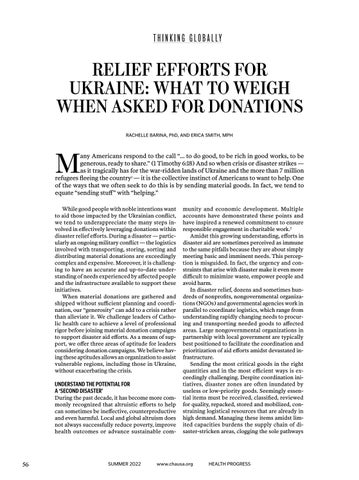T H I N K I N G G L O B A L LY
RELIEF EFFORTS FOR UKRAINE: WHAT TO WEIGH WHEN ASKED FOR DONATIONS RACHELLE BARINA, PhD, AND ERICA SMITH, MPH
M
any Americans respond to the call “… to do good, to be rich in good works, to be generous, ready to share.” (1 Timothy 6:18) And so when crisis or disaster strikes — as it tragically has for the war-ridden lands of Ukraine and the more than 7 million refugees fleeing the country1 — it is the collective instinct of Americans to want to help. One of the ways that we often seek to do this is by sending material goods. In fact, we tend to equate “sending stuff” with “helping.” While good people with noble intentions want to aid those impacted by the Ukrainian conflict, we tend to underappreciate the many steps involved in effectively leveraging donations within disaster relief efforts. During a disaster — particularly an ongoing military conflict — the logistics involved with transporting, storing, sorting and distributing material donations are exceedingly complex and expensive. Moreover, it is challenging to have an accurate and up-to-date understanding of needs experienced by affected people and the infrastructure available to support these initiatives. When material donations are gathered and shipped without sufficient planning and coordination, our “generosity” can add to a crisis rather than alleviate it. We challenge leaders of Catholic health care to achieve a level of professional rigor before joining material donation campaigns to support disaster aid efforts. As a means of support, we offer three areas of aptitude for leaders considering donation campaigns. We believe having these aptitudes allows an organization to assist vulnerable regions, including those in Ukraine, without exacerbating the crisis.
UNDERSTAND THE POTENTIAL FOR A ‘SECOND DISASTER’
During the past decade, it has become more commonly recognized that altruistic efforts to help can sometimes be ineffective, counterproductive and even harmful. Local and global altruism does not always successfully reduce poverty, improve health outcomes or advance sustainable com-
56
SUMMER 2022
munity and economic development. Multiple accounts have demonstrated these points and have inspired a renewed commitment to ensure responsible engagement in charitable work.2 Amidst this growing understanding, efforts in disaster aid are sometimes perceived as immune to the same pitfalls because they are about simply meeting basic and imminent needs. This perception is misguided. In fact, the urgency and constraints that arise with disaster make it even more difficult to minimize waste, empower people and avoid harm. In disaster relief, dozens and sometimes hundreds of nonprofits, nongovernmental organizations (NGOs) and governmental agencies work in parallel to coordinate logistics, which range from understanding rapidly changing needs to procuring and transporting needed goods to affected areas. Large nongovernmental organizations in partnership with local government are typically best positioned to facilitate the coordination and prioritization of aid efforts amidst devastated infrastructure. Sending the most critical goods in the right quantities and in the most efficient ways is exceedingly challenging. Despite coordination initiatives, disaster zones are often inundated by useless or low-priority goods. Seemingly essential items must be received, classified, reviewed for quality, repacked, stored and mobilized, constraining logistical resources that are already in high demand. Managing these items amidst limited capacities burdens the supply chain of disaster-stricken areas, clogging the sole pathways
www.chausa.org
HEALTH PROGRESS
